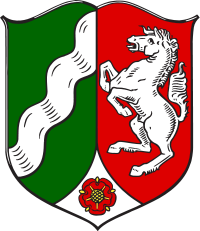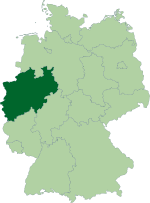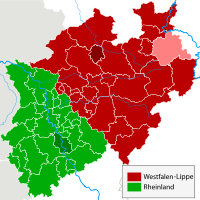- Coat of arms of North Rhine-Westphalia
-
Coat of arms of North Rhine-Westphalia 

Area the arms representDetails Armiger North Rhine-Westphalia Adopted 1948 Escutcheon per pale: 1 the former Rhine Province, 2 the former Province of Westphalia, and enté en point embowed: the former Free State of Lippe Predecessors Rhine Province, Province of Westphalia, Free State of Lippe Use within the German state of North Rhine-Westphalia The Coat of Arms of North Rhine-Westphalia is the official coat of arms of the German state of North Rhine-Westphalia.
After World War II on August 23, 1946 the British military administration in Germany established the new state of North Rhine-Westphalia with the merger of the Province of Westphalia and the northern parts of the Rhine Province, to which in January 1947 the Free State of Lippe was added. That same year Wolfgang Pagenstecher, a famous German heraldist living in Düsseldorf, made the original blazon for the newly created state, which adopted it on February 5, 1948. On March 10, 1953 this has been confirmed by the Law about the state's colours, the state's coat of arms and the state' s flag.
The named law starts as follows:
...[1]
§ 1 The state's colors are green-white-red.
§ 2 The state's coat of arms is party per pale Vert a bend sinster wavy Argent and Gules a horse rampant Argent, enté en point embowed Argent a rose Gules seeded and leaved Or.—State Government of North Rhine Westphalia, Law about the state's colours, the state's coat of arms and the state' s flag of March 10, 1953So the constituent three parts of this coat of arms are:
- dexter: Vert a bend sinster wavy Argent, which is a reflection of the former coat of arms of the Rhine Province. This until than showed a bend wavy, representing the river Rhine flowing through the Rhineland, today's southwestern part of the state. The change from bend to bend sinister has only been done because of aesthetical reasons.
- sinister: Gules a horse rampant Argent, as opposed to the jumping horse in the arms of Lower Saxony, representing Westphalia, the northeastern part of the state. Originally it was the Saxon steed, the emblem of the Saxon stern duchy. It is identical to the preceding coat of arms of the Province of Westphalia.
- enté en point embowed: Argent a rose Gules seeded and leaved Or, showing the rose of Lippe. This was the coat of arms of the Principality of Lippe, now the district of Lippe in the east of the state.
The coat of arms appears as a charge on the state flag of North Rhine-Westphalia.
References
- ^ Der Landtag des Landes Nordrhein Westfalen (March 21, 1953), "Gesetz über die Landesfarben, das Landeswappen und die Landesflagge" (PDF), Gesetz und Verordnungsblatt für das Land Nordrhein Westfalen: 219–220, http://www.landtag.nrw.de/portal/WWW/dokumentenarchiv/Dokument/XMMGVB5321.pdf
See also
- List of coats of arms of the districts in North Rhine-Westphalia
- Coat of arms of Prussia
- Coat of arms of Germany
- Origin of the coats of arms of German federal states.
Coats of arms of Germany German states Baden-Württemberg • Bavaria • Berlin • Brandenburg • Bremen • Hamburg • Hesse • Lower Saxony • Mecklenburg-Vorpommern • North Rhine-Westphalia • Rhineland-Palatinate • Saarland • Saxony • Saxony-Anhalt • Schleswig-Holstein • Thuringia Categories:
Categories:- German coats of arms
- North Rhine-Westphalia
Wikimedia Foundation. 2010.

